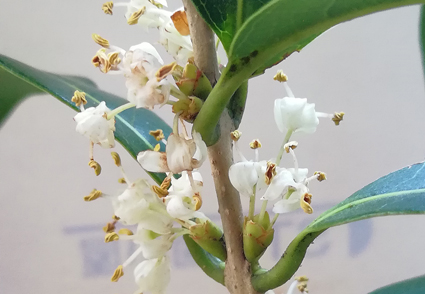Abstract
We describe and illustrate Osmanthus dechangensis J.L.Liu & Y.Yuan, a new species within the Oleaceae family, endemic to Sichuan, China. This evergreen shrub or tree is characterized by inflorescences clustered in the leaf axils and at branch tips. The leaves, which are either entire or exhibit spiny serrations, are complemented by bracts that are hairy or ciliate along the margins. The species is dioecious, bearing separate male and hermaphroditic flowers. While O. dechangensis shares some similarities with O. yunnanensis and other closely related species, it bears distinct morphological traits, including glabrous young twigs and larger leaves measuring (6.5–)8.2–23.3 cm in length, with (8–)10–25 pairs of lateral veins. The cymose inflorescences are supported by a peduncle of (0.5–)1–3 mm in length and feature more bracts, arranged in (5–) 6–8 layers with (10–) 12–16 individual bracts. The flowers are larger, with the calyx measuring 1.5–2 mm in length, the corolla 6–7 mm long, featuring a corolla tube of 1–2 mm and lobes measuring (4.5–)5–6 mm in length. The stamens are inserted near the mouth of the corolla tube. The filaments are partially fused to the corolla tube for about 2 mm, extending freely for 2.5–3.5 mm, with anthers measuring (2.5–)3–3.5 mm in length. In hermaphroditic flowers, the connectives do not protrude, while in male flowers, they extend slightly as a small apical projection. The species' distinct flowering period, from January to February, further differentiates it from closely related taxa.
References
- Bai, P.Y. (1983) New taxa of Oleaceae from Yunnan. Acta Botanica Yunnanica 5: 177–182.
- Beijing Institute of Botany, Chinese Academy of Sciences. (1974) Atlas of Chinese Higher Plants (Vol. 3). Science Press, Beijing, China, 4662 pp.
- Ben Mahmoud, K., Mezzapesa, G.N., Abdelkefi, F. & Perrino, E.V. (2024) Nutritional value and functional properties of an underexploited Tunisian wild beet (Beta macrocarpa Guss.) in relation to soil characteristics. Euro-Mediterranean Journal for Environmental Integration 9: 705–720. https://doi.org/10.1007/s41207-024-00468-5
- Brullo, S., Tomaselli, V. & Wagensommer, R.P. (2015) A new species of Odontites (Orobanchaceae) from southern Italy. Phytotaxa 213 (3): 271–281. https://doi.org/10.11646/phytotaxa.213.3.7
- Chang, H.T. (1982) New records of Oleaceous flora from China. Acta Scientiarumu Naturalium Universitatis Sunyatseni 21: 1–16.
- Chang, M.C., Qiu, L.Q., Wei, Z. & Green, P.S. (1996) Flora of China (Vol. 15). Science Press, Beijing, Missouri Botanical Garden Press, St. Louis, 286–292 pp.
- Chen, R. (1937) Classification of Chinese Trees. Jinghua Bookstore, Nanjing, China, 1020 pp.
- Chinchilla, I.F. (2020) A new tree species of Cupania (Sapindoideae, Sapindaceae) from Quepos, Costa Rica. Phytotaxa 475 (3): 178–186. https://doi.org/10.11646/phytotaxa.475.3.2
- Editorial Committee of Flora of China, Chinese Academy of Sciences (1992) Flora of China (Vol. 61). Science Press, Beijing, China, pp. 85–111.
- El Zein, H. & Bottcher, L. (2024) Salvia josetta (Nepetoideae; Lamiaceae), a new species from Lebanon. Phytotaxa 644 (3): 190–200. https://doi.org/10.11646/phytotaxa.644.3.2
- Green, P.S. (1958) A monographic revision of Osmanthus in Asia and America. Notes from the Royal Botanic Garden Edinburgh 22: 439–542.
- IUCN (2024) Guidelines for Using the IUCN Red List Categories and Criteria. Version 16. Prepared by the Standards and Petitions Committee. Available from: https://www.iucnredlist.org/resources/redlistguidelines (accessed 6 April 2024)
- Ji, C.F. (2004) Systematic taxonomy of the genus Osmanthus (Oleaceae) [PhD dissertation]. Nanjing Forestry University, Nanjing, China, 1–105pp.
- Kunming Institute of Botany, Chinese Academy of Sciences. (1986) Flora of Yunnan (Vol. 4). Science Press, Beijing, China, 622 pp.
- Latt, M.M., Tanaka, N. & Park, B.B. (2023) Two new species of Impatiens (Balsaminaceae) from Myanmar. Phytotaxa 583 (2): 141–152. https://doi.org/10.11646/phytotaxa.583.2.2
- Lei, R.H., Yu, X.L. & Wang, L.Q. (2008) Research on the Introduction of Osmanthus fragrans Community in China. Journal of Anhui Agricultural Sciences 36: 2337–2354. https://doi.org/10.13989/j.cnki.0517-6611.2008.06.106
- Liu, D.J. (1988) A new species of Osmanthus from Guizhou. Acta Botanica Yunnanica 10: 121–122.
- Liu, J.L., Meng, X.X. & Feng, J.Z. (2007) The seed plants in Panxi area of Sichuan Province. Tsinghua University Press, 342 pp.
- Liu, L.C. & Xiang, Q.B. (2003) Research progress on Osmanthus genus. Journal of Nanjing Forestry University (Natural Sciences Edition) 27: 84–88. https://doi.org/10.3969/j.jssn.1000-2006.2003.02.020
- Liu, Y.L. (1993) Cultivar classification of Osmanthus fragrans Lour. and the development of germplasm resources of Osmanthus Lour. Journal of Plant Resources and Environment 2: 44–48.
- Loureiro, J. de (1790) Flora Cochinchinensis : sistens plantas in regno Cochinchina nascentes : quibus accedunt aliae observatae in Sinensi imperio, Africa orientali, Indiaeque locis variis : omnes dispositae secundum systema sexuale Linnaeanum (Vol. 1). Ulyssipone, Typis, et expensis Academicis, Lisboa, 29 pp. https://doi.org/10.5962/bhl.title.40199
- Lu, R.L. (1989) Notes on the Genus Osmanthus in China. Acta Phytotaxonomica Sinica 27: 71–74.
- Lu, S.Y. (1985) A revision of the genera Osmanthus in Taiwan. Quarterly Journal of Chinese Forestry 18: 79–92. https://doi.org/10.5771/0506-7286-1985-1-92
- Shang, F.D., Yi, Y.J., Hu, N. & Xiang, Q.B. (2002) Studies on the Germplasm Resources and Systematic Classification of Osmanthus. Journal of Henan University (Natural Sciences) 32: 47–50. https://doi.org/10.3969/j.issn.1003-4978.2002.03.012
- Siti-Munirah, M.Y. & Dome, N. (2023) Thismia kenyirensis (Thismiaceae), a new species from Taman Negeri Kenyir, Terengganu, Peninsular Malaysia. PhytoKeys 221: 61–72. https://doi.org/10.3897/phytokeys.221.98571
- Song, X.H. (1984) New Taxa and New Distributions of Woody plants from Guizhou Province. Journal of Nanjing Forestry University (Natural Sciences Edition) 8: 46–52. https://doi.org/10.3969/j.jssn.1000-2006.1984.04.006
- Swanepoel, W., de Cauwer, V. & Van Wyk, A.E. (2021) A new rheophytic species of Syzygium (Myrtaceae) from the lower Kunene River of Angola and Namibia. Phytotaxa 491 (4): 281–290. https://doi.org/10.11646/phytotaxa.491.4.3
- Thiers, B. (2024) Index Herbariorum: A global directory of public herbaria and associated staff. New York Botanical Garden’s Virtual Herbarium. Available from: http://sweetgum.nybg.org/science/ih/ (accessed 28 November 2024)
- Tibetan Plateau Comprehensive Scientific Expedition Team of the Chinese Academy of Sciences. (1986) Flora of Xizang (Vol. 3). Science Press, Beijing, China, 829 pp.
- Xiang, Q.B. & Ji, C.F. (2004) A Checklist for the Genus of Osmanthus. Journal of Nanjing Forestry University (Natural Science Edition) 47: 45–57. https://doi.org/10.3969/j.jssn.1000-2006.2004.07.008
- Xie, W.Y., Liu, X., Mei, X.D., Chen, F. & Chen, Z.H. (2021) Osmanthus austrozhejiangensis (Oleaceae), a new species from Zhejiang. Guihaia 41: 10–15. https://doi.org/10.11931/guihaia.gxzw201907069


